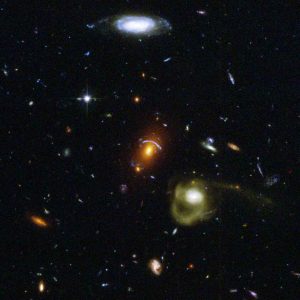
When I took physics in college, I seem to remember a formula that related the wavelength of light to its energy. Could the wavelength of a photon of light be altered by a loss of energy, however small, over its path through intergalactic space?
If that were true, looking at a trip of millions / billions of light years… wouldn’t that have some effect on our measurements of redshift, distances, and the expansion rate of the universe?
The answer to your first question is yes, for all intents and purposes, photons traveling through intergalactic space could, and in fact do, lose energy due to the expansion of spacetime in the Universe. As the photons lose energy their wavelengths become longer. As you recall, there is a formula that relates a photon’s energy to it’s wavelength: E = h*c/lambda, or in words, the energy of photon equals Planck’s constant times the speed of light divided by the photon’s wavelength. Click here for a more detailed discussion of this equation.
As for your second question (Does this effect impact our measurements of redshifts, distances, and the expansion of the universe?), in principle yes it has an impact, but in practice, even if it’s not taken into account, the impact is very small.
In astronomy, redshift measurements are actually the measurement of the energy lost by photons emitted from a distance source due to the expansion of the universe. Astronomers measure this loss of energy by measuring the shift in the wavelength of spectral lines in galaxy spectra, for example. They are called “redshifts” because the spectral lines of distant galaxies are always shifted to longer wavelengths or to the “red.”
As for measurements of distances, astronomers use many techniques to measure distances which are affected by photon “energy loss” to a varying degree. Some methods like the parallax technique do not depend on the energy of photons at all and other methods depend on the energy of photons to a large degree, like using Cepheid variable stars and their period-luminosity relation, or using the light curves of Type Ia supernovae. But even for the latter methods, the effect of photon “energy-loss” on the distance measurement is about one percent or less while other factors effect the distance measurement to a larger extent, like light contamination (or blending) from other stars, the varying extinction (or dimming) effect of dust near the Cepheid, and/or the uncertainty in our models of how Cepheid variable stars and supernovae work. These effects result in distance measurements that are uncertain by 5-17%!
So in conclusion, photons can lose energy while traveling through space, astronomers measure this loss of energy by measuring redshifts, and our measurements of distance (and therefore the expansion of the universe) are impacted by this effect but only slightly and if it’s not taken into account by the astronomers doing the measuring.
Regards,
Matt Stevans
UT Austin